Related Research Articles

Captain Frederick Marryat was a Royal Navy officer, a novelist, and an acquaintance of Charles Dickens. He is noted today as an early pioneer of nautical fiction, particularly for his semi-autobiographical novel Mr Midshipman Easy (1836). He is remembered also for his children's novel The Children of the New Forest (1847), and for a widely used system of maritime flag signalling known as Marryat's Code.
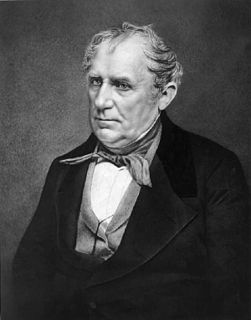
James Fenimore Cooper was an American writer of the first half of the 19th century. His historical romances depicting colonist and Indigenous characters from the 17th to the 19th centuries created a unique form of American literature. He lived much of his boyhood and the last fifteen years of life in Cooperstown, New York, which was founded by his father William Cooper on property that he owned. Cooper became a member of the Episcopal Church shortly before his death and contributed generously to it. He attended Yale University for three years, where he was a member of the Linonian Society.
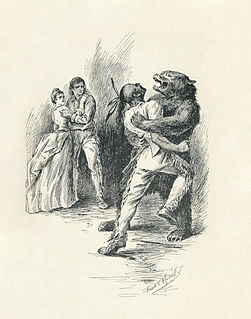
The Last of the Mohicans: A Narrative of 1757 is a historical novel written by James Fenimore Cooper in 1826.

Hell Gate is a narrow tidal strait in the East River in New York City. It separates Astoria, Queens from Randall's and Wards Islands.
Rodman Philbrick is an American writer of novels for adults and children.
The line-crossing ceremony is an initiation rite that commemorates a person's first crossing of the Equator. The tradition may have originated with ceremonies when passing headlands, and become a "folly" sanctioned as a boost to morale, or have been created as a test for seasoned sailors to ensure their new shipmates were capable of handling long, rough voyages. Equator-crossing ceremonies, typically featuring King Neptune, are common in the navy and are also sometimes carried out for passengers' entertainment on civilian ocean liners and cruise ships. They are also performed in the merchant navy and aboard sail training ships.
Captain Richard Martin Woodman LVO is an English novelist and naval historian who retired in 1997 from a 37-year nautical career, mainly working for Trinity House, to write full-time.

Redburn: His First Voyage is the fourth book by the American writer Herman Melville, first published in London in 1849. The book is semi-autobiographical and recounts the adventures of a refined youth among coarse and brutal sailors and the seedier areas of Liverpool. Melville wrote Redburn in less than ten weeks. While one scholar describes it as "arguably his funniest work", scholar F. O. Matthiessen calls it "the most moving of its author's books before Moby-Dick".

The Pilot: A Tale of the Sea is a historical novel by James Fenimore Cooper, first published in January 1824. Its subject is the life of a naval pilot during the American Revolution. It is often considered the earliest example of nautical fiction in American literature.
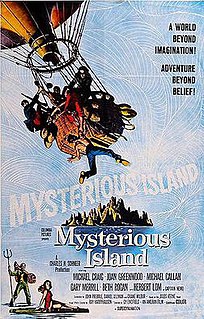
Mysterious Island is a 1961 science fiction adventure film about prisoners in the American Civil War who escape in a balloon and then find themselves stranded on a remote island populated by giant and tiny animals.
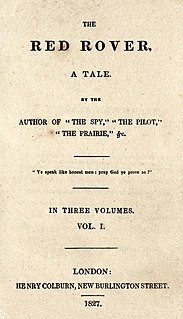
The Red Rover is a novel by American writer James Fenimore Cooper. It was originally published in Paris on November 27, 1827, before being published in London three days later on November 30. It was not published in the United States until January 9, 1828, in Philadelphia. Soon after its publication it was adapted for theater both in the United States and in England.
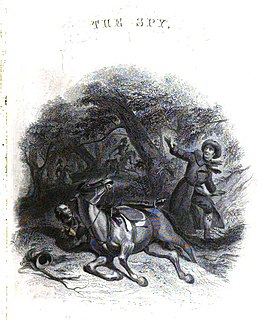
The Spy: a Tale of the Neutral Ground is a novel by American writer James Fenimore Cooper. His second novel, it was published in 1821 by Wiley & Halsted. The plot is set during the American Revolution and was inspired in part by the family friend John Jay. The Spy was successful and began Cooper's reputation as a popular and important American writer.
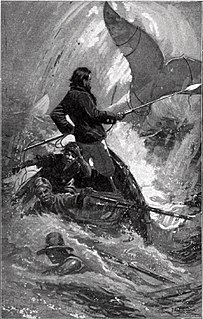
Nautical fiction, frequently also naval fiction, sea fiction, naval adventure fiction or maritime fiction, is a genre of literature with a setting on or near the sea, that focuses on the human relationship to the sea and sea voyages and highlights nautical culture in these environments. The settings of nautical fiction vary greatly, including merchant ships, liners, naval ships, fishing vessels, life boats, etc., along with sea ports and fishing villages. When describing nautical fiction, scholars most frequently refer to novels, novellas, and short stories, sometimes under the name of sea novels or sea stories. These works are sometimes adapted for the theatre, film and television.

Mercedes of Castile; or, The Voyage to Cathay is an 1840 historical novel by James Fenimore Cooper. The novel is set in 15th-century Europe, and follows the preparations and expedition of Christopher Columbus westward to the new world.
The Water-Witch is an 1830 novel by James Fenimore Cooper. Set in 17th century New York and the surrounding sea, the novel depicts the abduction of a woman, Alida de Barbérie, by the pirate captain of the brigantine Water-Witch, and the subsequent pursuit of that elusive ship by her suitor, Captain Ludlow.
The Two Admirals is an 1842 nautical fiction novel by American author James Fenimore Cooper. The novel was written after the Leatherstocking Tales novel The Deerslayer. Set during the 18th century and exploring the British Royal Navy, Cooper wrote the novel out of encouragement of his English publisher, who recommended writing another sea novel. Cooper had originally intended to write a novel where ships were the main characters, though eventually decided not to. The novels is one of three novels which Cooper would revise for editions following their first printing, the other two being The Pathfinder and Deerslayer.

The Oak Openings; or, The Bee Hunter is an 1848 novel by James Fenimore Cooper. The novel focuses on the activities of professional honey-hunter Benjamin Boden, nicknamed "Ben Buzz". The novel is set in Kalamazoo, Michigan's Oak Opening, a wooded prairie that still exists in part today, during the War of 1812.
The Wing-and-Wing; Or, Le Feu-Follet is an 1842 sea novel by American author James Fenimore Cooper. The novel includes a thematic interest in religiosity and faith. The novel also introduces metacriticism into Cooper's sea fiction, as does The Sea Lions, unlike earlier novels which typically also focused on nautical and nationalist themes.
The Headsman: The Abbaye des Vignerons is an 1833 novel by James Fenimore Cooper set in Switzerland. The novel was inspired by one of Cooper's trips during his European travels in 1832. The novel is one of three of Cooper's "European" novels, following The Bravo and The Heidenmauer, all of which use the European setting to deal with socio-political contrast with American institutions.

Until Bill's death, Bill & Laurel Cooper were a married couple who were successful co-authors of several nautical books and travelogues. For a record number of decades, they lived afloat on a succession of boats, including a ketch sailing boat, a Dutch barge, and a motor boat of their own design.
References
- 1 2 3 4 Langley, Harold D. (Fall 1997). "Images of the Sailor in the Novels of James Fenimore Cooper". The American Neptune. 57 (4): 359–370. Retrieved August 8, 2015– via Cooper Society Website, June 2001.
- 1 2 3 4 5 Philbrick, Thomas (Fall 1997). "Fact and Fiction: Uses of Maritime History in Cooper's Afloat and Ashore". The American Neptune. 57 (4): 315–321 – via Cooper Society Website, June 2001.
- 1 2 3 Cooper, Susan Fenimore. "Afloat and Ashore (1844)". Introductions to Novels by James Fenimore Cooper. Retrieved August 8, 2015– via James Fenimore Cooper Society.